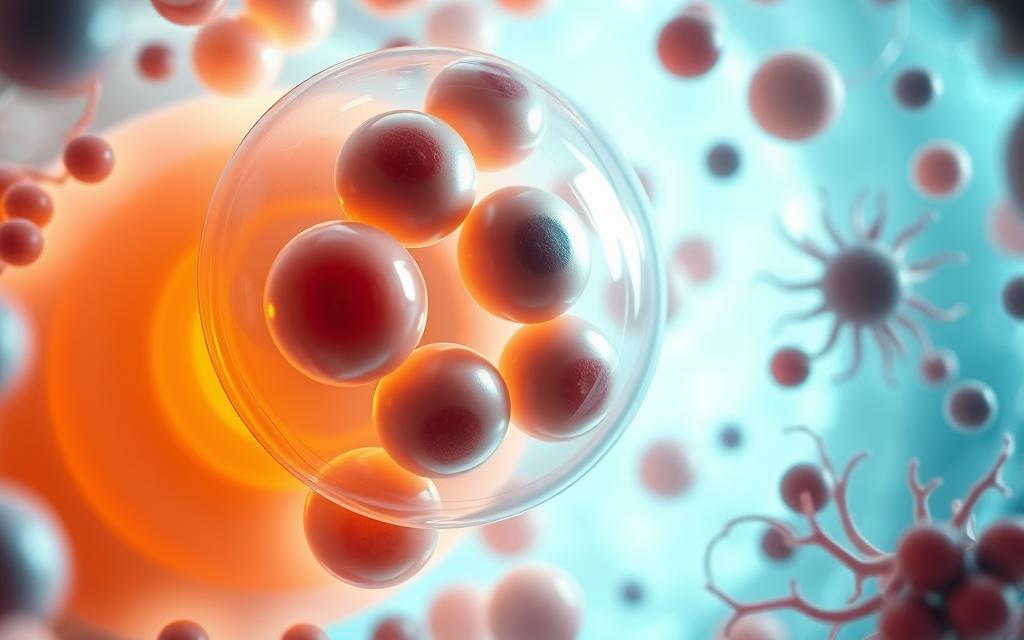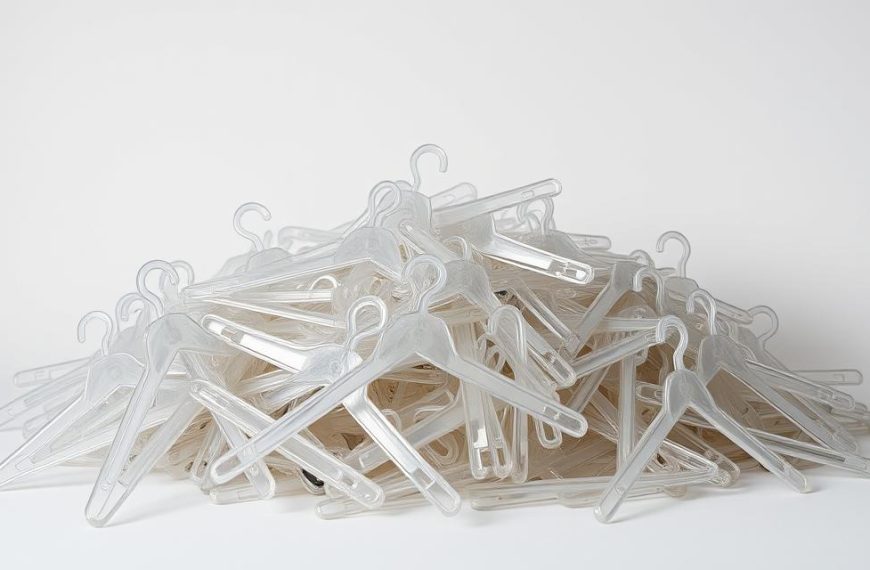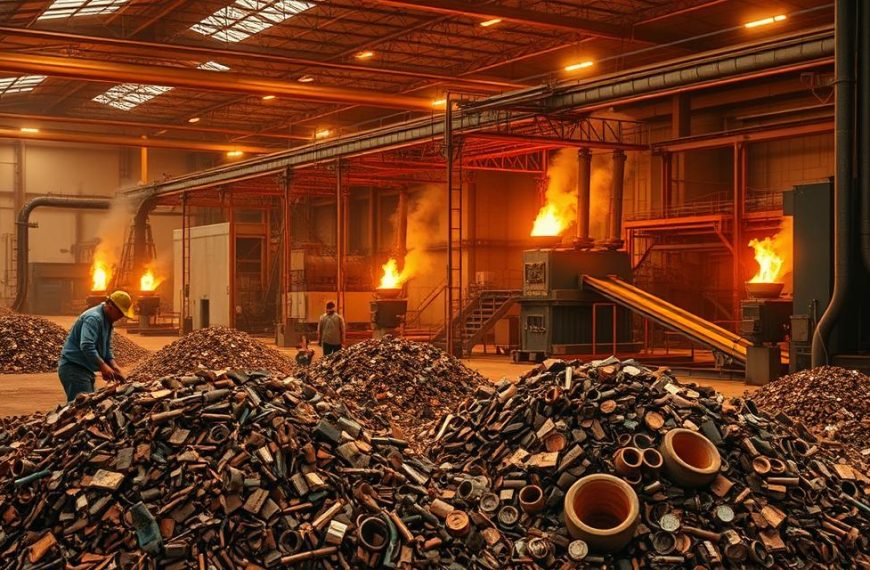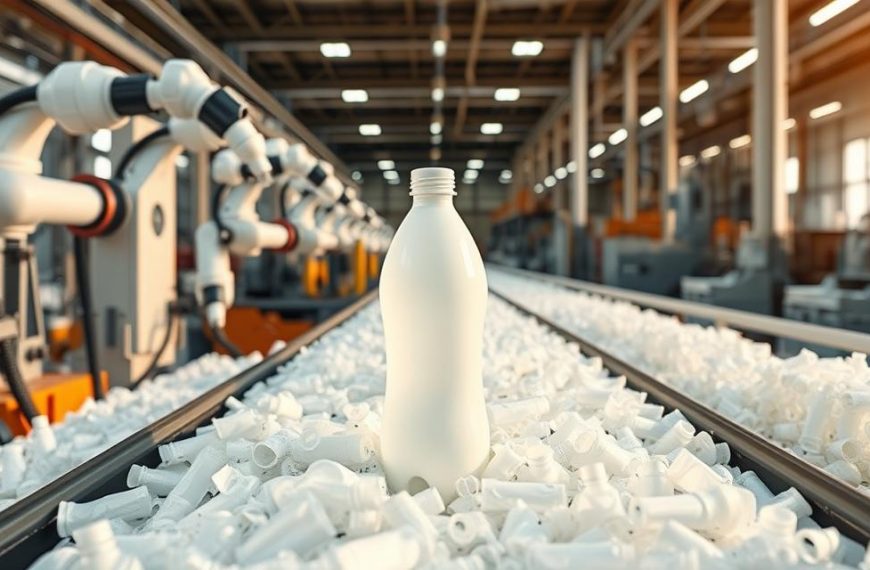In biology, lysosomes are known as the primary recycling centers within eukaryotic cells. These membrane-bound organelles play a crucial role in maintaining cellular health. They contain digestive enzymes that break down waste materials and recycle essential components.
Lysosomes function in a process called autophagy, where they degrade unwanted or damaged materials. This ensures that cells remain efficient and healthy. For example, the human liver recycles nearly half its components weekly, thanks to these powerful organelles.
Their acidic environment, combined with acid hydrolases, allows for efficient breakdown of macromolecules. Lysosomes are also part of the endomembrane system, working closely with the ER, Golgi apparatus, and vesicles. This collaboration ensures seamless cellular function and renewal.
Introduction to Lysosomes: The Cell’s Recycling Centers
Acidic and enzyme-packed, lysosomes are key to cellular maintenance. These organelles break down waste and recycle essential components, ensuring cells function efficiently. Their unique structure and composition make them indispensable in biology.
What Are Lysosomes?
Lysosomes are acidic vesicles filled with digestive enzymes. Unlike mitochondria or peroxisomes, they specialize in breaking down proteins, RNA/DNA, and lipids. This process keeps cells clean and functional.
Structure and Composition of Lysosomes
Each lysosome has a bilayer membrane that protects its acidic interior. Enzymes like proteases and nucleases are produced in the rough ER and processed in the Golgi apparatus. These components are then transported to lysosomes for action.
How Lysosomes Differ from Other Organelles
Unlike vacuoles or proteasomes, lysosomes require a low pH (4.5-5.0) to activate their acid hydrolases. This acidic environment ensures efficient waste breakdown. They also play a role in lipid synthesis and protein modification, linking them to the smooth ER and Golgi system.
“Lysosomes are the cell’s cleanup crew, ensuring nothing goes to waste.”
For more details on lysosomes, explore their fascinating role in cellular biology.
The Role of Lysosomes in Cellular Recycling
Lysosomes act as cellular recyclers, breaking down waste and recycling essential materials. These organelles ensure cells remain efficient by digesting unwanted components. Their acidic environment and specialized enzymes make them indispensable for cellular health.
Breaking Down Waste Materials
Lysosomes handle both extracellular debris and intracellular waste. Through phagocytosis, they engulf and digest external particles. Autophagy, on the other hand, targets damaged or unnecessary internal components. This dual process keeps cells clean and functional.
Autophagy: Recycling Cellular Components
Autophagy is a critical process where lysosomes degrade damaged mitochondria and other organelles. Autolysosomes form to break down these materials into reusable monomers. These monomers are then transported back into the cytosol for new synthesis, ensuring nothing goes to waste.
Enzymes in Lysosomes and Their Functions
Lysosomes contain a variety of enzymes that target specific materials. Proteases break down proteins into amino acids. Nucleases degrade RNA and DNA, while lipases hydrolyze lipids. These enzymes ensure efficient recycling of cellular components.
“Lysosomes are nature’s way of ensuring cellular efficiency through recycling.”
For example, liver cells renew nearly half their components weekly, thanks to lysosomal activity. This highlights the importance of these organelles in maintaining cellular health and longevity.
Lysosomes and Longevity: Signaling Beyond Recycling
Beyond their role in waste management, lysosomes influence aging and longevity. These organelles act as messengers, sending signals that impact cellular health and lifespan. Recent research highlights their importance in coordinating longevity across tissues.
Lysosomes as Messengers in Aging
Dr. Meng Wang’s study at Baylor College reveals lysosomes produce dihomo-gamma-linoleic acid. This fatty acid extends lifespan in C. elegans by 20-25 days. Neurons detect these signals from fat tissue, showcasing lysosomes’ role in intercellular communication.
Research on Lysosomal Signals and Lifespan
Fatty acid molecules coordinate longevity across tissues, ensuring cellular health. Xiaochen Wang praises the validity of in vivo studies, emphasizing their impact on understanding aging. This research opens doors to potential medical breakthroughs.
Implications for Human Health and Longevity
With the global aging population projected to reach 1.5 billion people by 2050, lysosome research holds immense medical potential. Declining lysosomal function is linked to age-related diseases like Alzheimer’s. Understanding these mechanisms could lead to innovative treatments.
“Lysosomes are not just recyclers; they are key players in the biology of aging.”
By exploring lysosomal signaling, scientists aim to unlock secrets to healthier, longer lives. This study of lysosomes offers hope for addressing age-related health challenges in the coming years.
Lysosomes in Cell Division and Disease
Lysosomes play a pivotal role in both cell division and disease progression. These organelles are not just recyclers but active participants in critical cellular processes. Their involvement in mitosis and links to cancer highlight their importance in biology and medicine.
Lysosomes’ Role in Mitosis
During mitosis, lysosomes position near the cell nucleus to release digestive enzymes. These enzymes cleave histone H3, a protein essential for DNA packaging. This process ensures proper DNA segregation, a critical step in cell division.
Research from the Danish Cancer Society highlights the importance of this mechanism. Without lysosomal activity, cells face problems in chromosome separation, leading to potential genetic instability.
Link Between Lysosomes and Cancer
Cancer cells often exhibit fragile lysosomal membranes. This fragility aids metastasis by allowing enzymes to leak into the cytoplasm. Targeting these membranes in the lab has shown promise in slowing cancer progression.
Marja Jäättelä’s galectin puncta assay is a groundbreaking research tool. It tracks lysosomal leakage, providing insights into cancer cell behavior. This method opens new avenues for therapeutic interventions.
Future Research Directions
Cholesterol’s impact on lysosomal membrane stability is a growing area of interest. High cholesterol levels increase cancer risk by weakening these membranes. Understanding this chain of events could lead to innovative treatments.
Future studies aim to explore how lysosomal dysfunction contributes to other diseases. By addressing these problems, scientists hope to improve cellular health and longevity.
“Lysosomes are more than cellular recyclers; they are key players in disease and health.”
As research advances, the role of lysosomes in biology continues to expand. Their dual function in cell division and disease makes them a focal point for future studies.
Conclusion
Lysosomes are essential for maintaining cellular balance and health. These organelles perform dual roles, breaking down waste and signaling across tissues. Their function in aging, disease prevention, and mitosis underscores their importance in biology.
Ongoing research, like Baylor’s fatty acid studies and Danish cancer links, reveals their broader impact. Understanding lysosomal communication networks could unlock new treatments for age-related diseases.
Dr. Meng Wang’s vision emphasizes healthy longevity over mere lifespan extension. As data grows, exploring lysosomes’ role in reducing cellular stress becomes crucial. Their study holds promise for improving health over time.

















